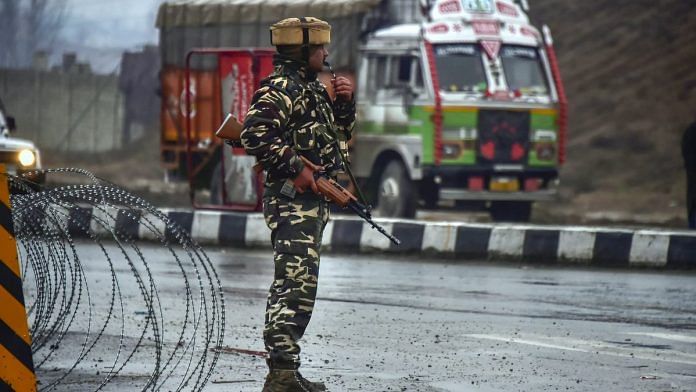New Delhi: The suicide attack on a CRPF convoy in Jammu & Kashmir’s Pulwama district raises a number of questions, the most troubling ones about possible intelligence failure in a state that has seen a resurgence of violence.
At least 40 personnel of the CRPF died in the attack Thursday, with many of the wounded said to be fighting for their life in hospital. The Jaish-e-Mohammad (JeM) of Masood Azhar subsequently claimed responsibility for the attack, identifying the bomber as a 20-year-old local.
The attack is the worst ever on security forces in Jammu & Kashmir’s long tryst with militancy.
Jammu & Kashmir Governor Satya Pal Malik said Friday that intelligence failure was partly responsible for the attack, adding that the security forces were not aware of any training of suicide bombers.
However, top security sources in Jammu & Kashmir as well as central security agencies, while saying that there was no specific intel about Thursday’s attack, disagreed.
“You cannot call it a intelligence collapse or failure because the last big attack by the JeM was in December 2017, which claimed the lives of five security personnel,” said a top source in J&K security establishment. “Since then, 56 JeM terrorists have been shot dead, including chief Masood Azhar’s nephew. Of the 56 killed, 41 were Pakistani terrorists,” the source added.
“We have prevented attacks since December 2017,” the source said, adding that attacks also happened in Afghanistan and other countries despite a tight security grid.
However, despite this, security experts have raised questions on how this attack happened. Some of the most important ones are:
Also read: US experts suspect Pakistan’s ISI agency of supporting those behind of Pulwama attack
How did explosives make their way into J&K?
What we know of the attack so far is that a convoy of 78 vehicles carrying 2,547 CRPF personnel was travelling down the Jammu-Srinagar national highway, when it was struck by a car or SUV laden with explosives and driven by a suicide bomber.
The highway, closed for a week because of snowfall, had recently reopened.
A day later, among the most prominent unanswered questions is, how did the explosives reach Jammu & Kashmir? Soon after the attack, the Pakistan-based JeM issued a statement claiming responsibility, saying they had used 350 kg of explosives.
Top security sources dispute this stated quantity, saying 350 kg of explosives would have taken out more vehicles in the convoy and not just one bus, as happened in the attack.
The quantity of explosives, they added, could actually be less than 100 kg.
However, the question is not how many kilogrammes of explosives were used. Even if less than 100 kg, it begs to be asked how the local JeM module got it.
How come no one sniffed out the deadly plot?
The kind of attack that took place Thursday would need weeks of planning, if not months, with multiple steps involved, including getting explosives, rigging the vehicle and training.
Multiple security agencies are deployed in the tense state to keep track of terrorists and their designs. It’s pertinent to ask how the movement of the cache of explosives into or within Kashmir, and the larger conspiracy, escaped their notice.
No one knew a local was being trained as a suicide bomber?
In a video that surfaced after the attack, the suspected bomber, Adil Ahmad Dar, is heard claiming that he was part of a suicide squad and had trained for this specific attack for six months.
The Governor has admitted that Dar had been on the radar, which raises another question, why did no one get a whiff that a local — and one that security agencies were watching — was being trained as a suicide bomber?
Agencies still mapping sequence of attack
Close to 24 hours after the attack, the security agencies were still in the process of mapping the sequence of events.
While initial reports suggested that the bombing was followed by a grenade attack and standoff fire from terrorists waiting on the sidelines, sources in the security agency now dispute this narrative.
It’s not yet clear whether the terrorist’s vehicle rammed into the CRPF bus, or intercepted it before the bomb was detonated.
The fact that the agencies are still trying to map the sequence of the attack shows that they were caught unawares.
Also read: Modi govt, Pakistan, China are all to blame for deadly Kashmir CRPF bombing




Very good. I was wanting that somebody must ask these questions. But there are some more as Ravi Ranjan on NDTV Primetime reported.
Jammu Srinagar highway is a high security zone where every civilian vehicles are checked and the passengers are scrutinized. How come they didn’t inspect the (explosives laden) SUV coming towards them. Besides,when military vehicles pass,they don’t allow civilians to pass by. We have experienced this when visiting Kashmir valley. Then how come a civilian drive an SUV and collides it without anyone suspecting?
I have observed whenever there’s any serious issue about govt functioning come to the fore, there’s a terror attack and during that attack, all kinds of security lapses take place. Two things have some connection definitely.